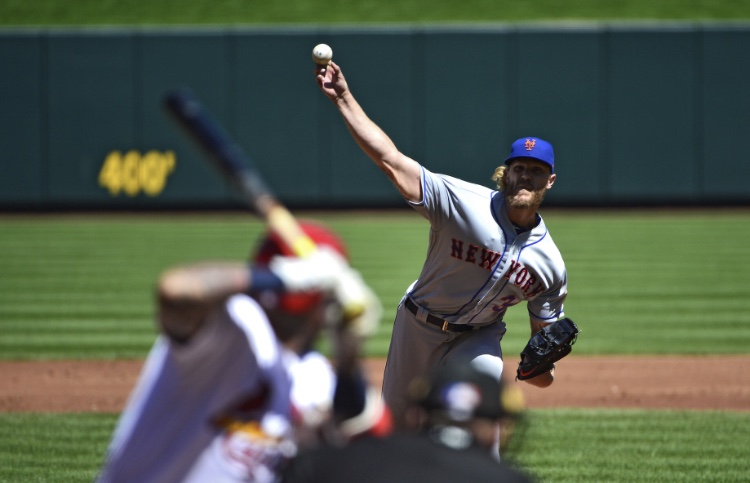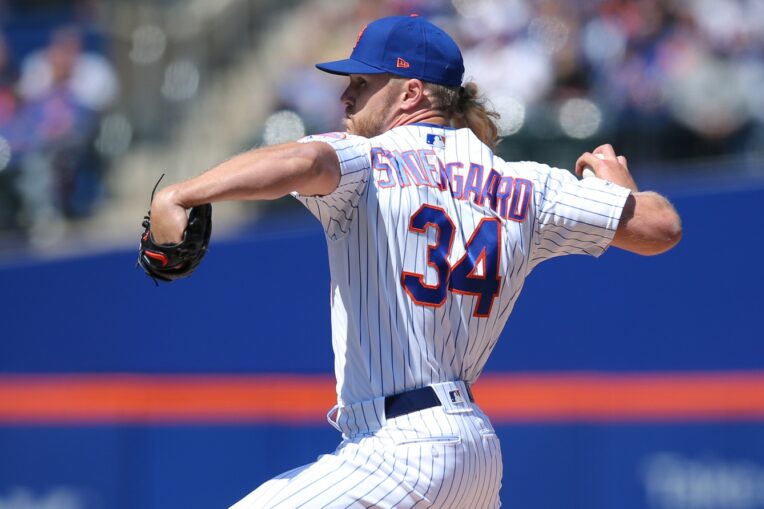
Noah Syndergaard watched Jacob deGrom put up stellar numbers for all of last season, and as any one should, he said, “I want to be more like him.” Coming into this season, Syndergaard made it known that he was planning on scrapping his 2-seam sinker and relying on his four-seam fastball after watching deGrom enjoy success with his four-seamer up in the zone.
In theory, emulating someone who dominated literally every time out is a good idea. In practice, “Thor” has actually become less effective to the tune of a 5.90 ERA across five starts. Before you say, “Hey! what about his 2.92 FIP,” he has given up more hits (30) than innings pitched (29.0), something he has never done before. With a career 8.2 H/9 rate coming into this season, his 9.3 mark so far in 2019 is cause for concern. But why is he giving up all these hits? While his ground ball percentage has remained constant, he has allowed far more fly balls than he has in the past. Why is that?
When answering these questions about Syndergaard, one should look first to the man he is attempting to model himself after – Jacob deGrom. The 2018 NL Cy Young Award winner threw 42.8% four-seam fastballs and only 9.2% sinkers (or two-seam fastballs) in his historic season. So how was he so effective throwing so many four-seamers compared to the just 21.2% Syndergaard threw?
While most of the league’s hitters subscribed to the idea of looking for something down in the zone to create launch angle from, most of the league’s pitchers were unable to adapt quickly enough. DeGrom, however, immediately picked up on the trend and threw most of those fastballs up in the strike zone, away from the launch-angle “happy zone.” The result was a massive increase in infield fly balls (9.8% in 2017 to 16.3% in 2018), a massive decrease in home runs to fly ball ratio (16.1% to 6.3%), an increase in soft-hit percentage (21.3% to 25.2%), and a decrease in hard-hit percentage (31.9% to 26.6%).
Essentially, deGrom threw his fastballs up in the zone where the hitters were not looking for them. When they were forced to swing at them, they were not able to get on top of the ball with their launch-angle swings, thus either popping it up or hitting it weakly somewhere. That is exactly what Noah Syndergaard is trying to accomplish this season.
The problem is, Syndergaard and deGrom’s four-seam fastballs are different. DeGrom’s, like Zack Wheeler‘s as well, has a lot more late life on it. Syndergaard’s, on the other hand, does not. A straight fastball is obviously easier to hit than one that moves, and that’s exactly what Syndergaard is discovering.
After throwing 32.3% sinkers and 21.2% four-seamers in 2018, Syndergaard has thrown 36.2% four-seamers and 23.5% sinkers so far in 2019. This (and other factors) has resulted in an increase in opposing hitters’ hard-hit percentage from 21.9% in 2018 to 27.2% this season.

Throwing more four-seam fastballs has also made his sinker worse. The sinker is a feel pitch, and if a pitcher doesn’t throw it enough, they could lose the feel for it, curtailing its effectiveness. After limiting batters to a .290 batting average (.268 xBA), .425 SLG (.381 xSLG), and .338 xOBA (.315) against his sinker in 2018, those numbers have increased this season. So far in 2019, against his sinker, opposing batters are hitting .348 (.299 xBA) with a .565 SLG (.544 xSLG) and .424 wOBA (.396 xwOBA).
Something both deGrom and Syndergaard shared last season was a high-velocity slider. Syndergaard’s slider averaged 92.0 mph compared to deGrom’s 91.1 mph and both were very effective with opposing batters hitting .205 off Syndergaard’s slider and .187 off deGrom’s. If Syndergaard was changing his fastball tendencies to match deGrom’s, then it makes sense to think that he should leave his slider alone, right?
While the change in his approach to throwing four-seamers and sinkers has backfired, the changes he’s made to his slider has had great results. While the average velocity on the pitch has decreased three full miles-per-hour from 92.0 to 89.0, opponents are hitting just .154 (.143 xBA) against it. Looking like a hard sweeping curveball, Thor has struck out more batters with it than any other pitch (11 of his 34 strikeouts have come on the slider) despite throwing it only 17.6% of the time. He has relied on it as his out pitch and rightfully so, as opponents swing and miss 33.3% of the times they see it.
Noah Syndergaard pitched very well last season. He went 13-4 with a 3.03 ERA and 2.80 FIP across 25 starts while throwing his sinker 32.3% of the time and four-seamers only 21.2% of the time. While it is a small sample size, the trends are showing that his adjustments regarding his fastballs have not worked while the adjustment to his slider has. Logic says to go back to what he was doing last year regarding his fastballs while keeping his new slider.
The problem with that logic is when Syndergaard finished 8th in Cy Young voting after going 14-9 with a 2.60 ERA and MLB-leading 2.29 FIP in 2016, he threw his four-seam fastball 35.2% of the time and his sinker at 23.9%. Those numbers are almost identical to his 2019 trends (36.2% fastballs, 23.5% sinkers) so it is clear that he is trying to go back to what gave him so much success in 2016.
Right now, though, it isn’t working. Hitters are squaring up both his fastballs and sinkers at an unprecedented rate and he must make an adjustment.
It is impressive how hard the 26-year-old is working to improve his game, and I laud him for it. At a certain point, though, it could reach the point of over-thinking. It may already be at that point, so it’s important not to let it continue. Syndergaard and Mets pitching coach Dave Eiland should stop focusing on what worked three years ago, and start focusing on what’s not working now.















